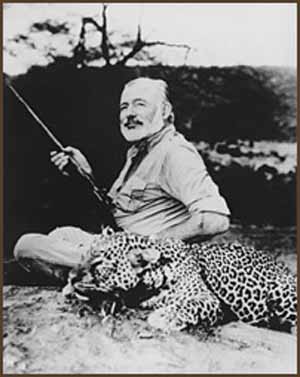 In
the middle of the 20th Century, Ernest Hemingway (1899-1961) was considered
unquestionably the dominant American literary figure. Even today, his works
are commonly circulated and regarded with great interest and discussion.
In
the middle of the 20th Century, Ernest Hemingway (1899-1961) was considered
unquestionably the dominant American literary figure. Even today, his works
are commonly circulated and regarded with great interest and discussion. About Ernest Hemingway
 In
the middle of the 20th Century, Ernest Hemingway (1899-1961) was considered
unquestionably the dominant American literary figure. Even today, his works
are commonly circulated and regarded with great interest and discussion.
In
the middle of the 20th Century, Ernest Hemingway (1899-1961) was considered
unquestionably the dominant American literary figure. Even today, his works
are commonly circulated and regarded with great interest and discussion.
Born and raised in Oak Park Illinois with his father Clarence Edmunds (a physician) and Grace Hall (a music teacher), he led a reasonably happy life. When he reached his teens, Hemingway had developed an interest in literature and wrote a weekly column for his high school newspaper, and contributed personal work to the school magazine.
Perhaps what made Hemingway’s work so unique was that he chased after adventure and violence and then transferred his own experiences and persona into his books. A fisherman, sportsman, serious writer and heavy drinking, Hemingway reflected many of the attributes of the characters in his stories, embedding their personalities with traits of heroism and courage. Some of Hemingway’s earliest works include a small pamphlet, Three Stories and Ten Poems, and a small book called In Our Time. It was these works that drove F. Scott Fitzgerald to recommend Hemingway to his publisher, Charles Scribners and Sons.
Hemingway’s longest novel, The Sun Also Rises, has been seen by many as the best of his works, but it was his novel A Farewell to Arms that launched Hemingway to fame in 1929. It was a love story set in World War I. Depending on his mood, Hemingway claimed to have rewritten the ending numerous times. He publishes his first non-fiction book, Death in the Afternoon in 1932. It was a study of bullfighting. The 1930s also saw Hemingway’s second collection of short stories, Winner Take Nothing, and two more full length books, Green Hills of Africa and To Have and to Have Not.
Hemingway’s longest novel, For Whom The Bell Tolls, was written in 1940 and eventually made into a successful movie. It was based on his experiences in the Spanish Civil War. It was in this decade that he divorced for the third time and married Mary Welsh. Throughout Hemingway’s literature, there is almost always an awkward failed relationship with a woman. Perhaps this could be the result of his many failed marriages. As his literary career seemed to be largely over, he came back in 1952 with the publication of the Old Man and the Sea, which first appeared in Life magazine. By the end of the 50s, Hemingway’s mental condition had deteriorated from heavy drinking and numerous plane crashes in Africa. In 1961, the man that had constantly incorporated images of heroes and courageous adventurers into his stories, cowardly shot himself through the mouth with a gun form his collection at his home in Idaho. Islands in the Stream, The Garden of Eden, and True at First Light were all assembled from his papers after his death, although all three books required heavy editing.
Hemingway has been awarded the 1954 Nobel Prize in Literature. His works are still read today. His best novels and short stories are written with a commanding narrative power and are often imitated, but never equaled. After all these years, he still remains a highly controversial writer and his work evokes an abundance of critical commentary, but he is also one of the greatest American writers of the twentieth century.
Images taken from Reflections of Greatness
Sources:
Ernest Hemingway
- Life and Works of
Home • Religion
in Old Man and the Sea • Fishing in the 50s
• World Politics
Life in Cuba • Baseball:
The Great DiMaggio • Characters in the Story
About Ernest Hemingway • About
this Site